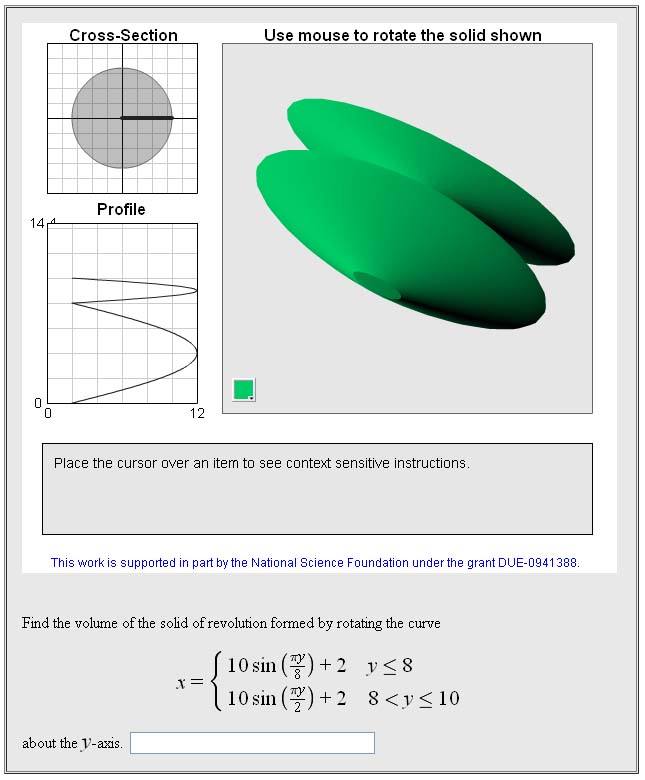SolidsWW Flash Applet Sample Problem 1
Flash Applets embedded in WeBWorK questions solidsWW Example
Sample Problem with solidsWW.swf embedded
This sample problem shows how to use this versatile applet.
A standard WeBWorK PG file with an embedded applet has six sections:
- A tagging and description section, that describes the problem for future users and authors,
- An initialization section, that loads required macros for the problem,
- A problem set-up section that sets variables specific to the problem,
- An Applet link section that inserts the applet and configures it, (this section is not present in WeBWorK problems without an embedded applet)
- A text section, that gives the text that is shown to the student, and
- An answer and solution section, that specifies how the answer(s) to the problem is(are) marked for correctness, and gives a solution that may be shown to the student after the problem set is complete.
The sample file attached to this page shows this; below the file is shown to the left, with a second column on its right that explains the different parts of the problem that are indicated above. A screenshot of the applet embedded in this WeBWorK problem is shown below:

There are other example problems using this applet:
solidsWW Flash Applet Sample Problem 2
solidsWW Flash Applet Sample Problem 3
And other problems using applets:
Derivative Graph Matching Flash Applet Sample Problem
USub Applet Sample Problem
trigwidget Applet Sample Problem
solidsWW Flash Applet Sample Problem 1
GraphLimit Flash Applet Sample Problem 2
Other useful links:
Flash Applets Tutorial
Things to consider in developing WeBWorK problems with embedded Flash applets
| PG problem file | Explanation |
|---|---|
##DESCRIPTION
## Solids of Revolution
##ENDDESCRIPTION
##KEYWORDS('Solids of Revolution')
## DBsubject('Calculus')
## DBchapter('Applications of Integration')
## DBsection('Solids of Revolution')
## Date('7/31/2011')
## Author('Barbara Margolius')
## Institution('Cleveland State University')
## TitleText1('')
## EditionText1('2011')
## AuthorText1('')
## Section1('')
## Problem1('')
########################################################################
# This work is supported in part by the National Science Foundation
# under the grant DUE-0941388.
########################################################################
|
This is the tagging and description section of the problem. Note that any line that begins with a "#" character is a comment for other authors who read the problem, and is not interpreted by WeBWorK. The description is provided to give a quick summary of the problem so that someone reading it later knows what it does without having to read through all of the problem code. All of the tagging information exists to allow the problem to be easily indexed. Because this is a sample problem there isn't a textbook per se, and we've used some default tagging values. There is an on-line list of current chapter and section names and a similar list of keywords. The list of keywords should be comma separated and quoted (e.g., KEYWORDS('calculus','derivatives')). |
DOCUMENT(); loadMacros( "PGstandard.pl", "AppletObjects.pl", "MathObjects.pl", ); |
This is the initialization section of the problem. The first executed line of the problem must be the
The |
TEXT(beginproblem());
$showPartialCorrectAnswers = 1;
Context("Numeric");
$a = random(2,10,1);
$b = random(2,10,1);
$xy = 'y';
$func1 = "$a*sin(pi*y/8)+2";
$func2 = "$b*sin(pi*y/2)+2";
$xmax = max(Compute("$a+2"),Compute("$b+2"),9);
$shapeType = 'circle';
$correctAnswer =Compute("64*$a+4*pi*$a^2+32*pi");
|
This is the problem set-up section of the problem.
The solidsWW.swf applet will accept a piecewise defined function either in terms of x or in terms of y. We set |
##########################################################################
# How to use the solidWW applet.
# Purpose: The purpose of this applet is to help with visualization of
# solids
# Use of applet: The applet state consists of the following fields:
# xmax - the maximum x-value. ymax is 7/5ths of xmax. the minima
# are both zero.
# captiontxt - the initial text in the info box in the applet
# shapeType - circle, ellipse, poly, rectangle
# piece: consisting of func and cut
# this is a function defined piecewise.
# func is a string for the function and
# cut is the right endpoint of the interval over which it is defined
# there can be any number of pieces
#
##########################################################################
# What does the applet do?
# The applet draws three graphs:
# a solid in 3d that the student can rotate with the mouse
# the cross-section of the solid (you'll probably want this to be
# a circle
# the radius of the solid which varies with the height
##############################################################################
###################################
# Create link to applet
###################################
$appletName = "solidsWW";
$applet = FlashApplet(
codebase => findAppletCodebase("$appletName.swf"),
appletName => $appletName,
appletId => $appletName,
setStateAlias => 'setXML',
getStateAlias => 'getXML',
setConfigAlias => 'setConfig',
maxInitializationAttempts => 10, # number of attempts to initialize applet
#answerBoxAlias => 'answerBox',
height => '550',
width => '595',
bgcolor => '#ffffff',
debugMode => 0,
submitActionScript => ''
);
###################################
# Configure applet
###################################
# configuration consists of hintState, question type, and random seed,
# and x-coordinates of four points where jumps, discontinuities or cusps
# occur.
$applet->configuration(qq{<xml><plot>
<xy>$xy</xy>
<captiontxt>'Compute the volume of the figure shown.'</captiontxt>
<shape shapeType='$shapeType' sides='3' ratio='1.5'/>
<xmax>$xmax</xmax>
<theColor>0x0000ff</theColor>
<profile>
<piece func='$func1' cut='8'/>
<piece func='$func2' cut='10'/>
</profile>
</plot></xml>});
$applet->initialState(qq{<xml><plot>
<xy>$xy</xy>
<captiontxt>'Compute the volume of the figure shown.'</captiontxt>
<shape shapeType='$shapeType' sides='3' ratio='1.5'/>
<xmax>$xmax</xmax>
<theColor>0x0000ff</theColor>
<profile>
<piece func='$func1' cut='8'/>
<piece func='$func2' cut='10'/>
</profile>
</plot></xml>});
TEXT( MODES(TeX=>'object code', HTML=>$applet->insertAll(
debug=>0,
includeAnswerBox=>0,
)));
|
This is the Applet link section of the problem.
Those portions of the code that begin the line with You must include the section that follows The lines The code
Answer submission and checking is done within WeBWorK. The applet is intended to aid with visualization and is not used to evaluate the student submission. |
BEGIN_TEXT
$BR
$BR Find the volume of the solid of revolution formed by rotating the
curve \[x=\begin{cases}$a\sin\left(\frac{\pi y}{8}\right)+2&y\le 8\\
$b\sin\left(\frac{\pi y}{2}\right)+2&8<y\le 10\end{cases}\] about the \(y\)-axis.
\{ans_rule(35) \}
$BR
END_TEXT
Context()->normalStrings;
|
This is the text section of the problem. The |
############################################################## # # Answers # ## answer evaluators ANS( $correctAnswer->cmp() ); #checks AnSwEr00003 ENDDOCUMENT(); |
This is the answer section of the problem. The problem answer is set by the
The |